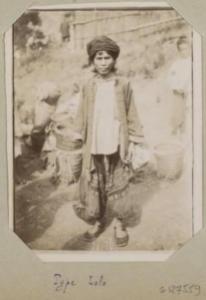I pointed out in the post below on “The Other Voices in ‘Vietnamese’ History” that in a place like the Nguyễn Dynasty empire the Việt were not the only people who recorded information. In particular, I pointed out that the Dao recorded a great deal as well.
Another people who recorded information were the Black Tai, or Tai Dam. A few years ago a Thai scholar wrote a wonderful dissertation on the topic of literacy among the Tai Dam in the area of what is now northwestern Vietnam: Yukti Mukdawijitra, “Ethnicity and Multilingualism: The Case of Ethnic Tai in The Vietnamese State” (Ph.D. dissertation, University of Wisconsin – Madison, 2007).
In his dissertation, Ajarn (i.e., “professor”) Yukti examines literacy among the Tai Dam from the pre-colonial period up to the present. I find the information that he provides about the pre-colonial period to be particularly fascinating, as it is a topic that we know so little about.
Some people may have heard of the Tai Dam text called the Kwam To Muang (hereafter KTM), or “story about the principality.” John Hartman at Northern Illinois University has done some preliminary work on that text (here), but as Ajarn Yukti points out in his dissertation, there is much more to this text than such introductions have revealed.
The traditional Tai Dam KTM contained three main parts. It opened with a call for people to listen to the recital of the text. This opening section was followed by a recital of the Tai Dam origin myth. And then the final, and longest, section related the historical chronology of the various Tai Dam muang (or principalities) that had existed from the past to the present.
The Tai Dam world was not politically unified. Therefore, each Tai Dam muang had its own KTM, however there was a point in the past where they all converged, or if we move from the past to the present, there was a point in the past where the line of transmission split and allowed for multiple muang to coexist. As such, the Tai Dam were politically divided but they all claimed to descend from a common ancestral clan in the distant past.
Ajarn Yukti explains how the KTM was only “read” on certain occasions. For instance, it was recited at the funeral of a muang chief. When the leader of a muang passed away, an elaborate funeral was held and as part of the ceremony, the chief’s son-in-law would read out loud the KTM.
Further, people would listen to the recitation of the KTM and Ajarn Yukti argues that this served as a way for them to “imagine their community” (sort of like the emergence of print capitalism enabled people in modern nations to imagine themselves as a nation, as Benedict Anderson has argued, as they can see by reading newspapers, for instance, that they are part of a community that is larger than the one they actually see with their eyes each day).
As such, within the Nguyễn Dynasty realm there was clearly more than one way of imagining community. While the production of historical texts at the imperial capital like the Khâm định Việt sử thông giám cương mục [Imperially Commissioned Itemized Summaries of the Comprehensive Mirror of Việt History] enabled the imagination of community through reading, the recitation of the KTM at the imperial periphery enabled the imagination of community through listening.
In other words, just as there were multiple voices within the Nguyễn Dynasty empire, so were there multiple ways of understanding the world and where one belonged in it.
[The two photographs above of “Lolo,” or what we would today call Dao, come from the French National Library, see here and here.]




This Post Has 2 Comments
The KTM is a book of history of the creation of Tai Dam People who immigrated from Sip Song Panna . The Tai Dam was forced to immigrate southward first to Guangdong province, then northwest of Vietnam.
The book could be read only when there was a funeral for a man. Because the country had been occupied by many foreign forces from generation to generation, so to tell the story of the creation of the country was secret politically in afraid of the oppressor accusations. It’s saying that to tell story for the deceased man.
Yea, this is what the Thai scholar who wrote a dissertation about this said. It’s fascinating. I know Thai, but not Tai Dam, but I would love to study this text with someone who knows it well. If you know anyone like that, feel free to let them contact me at leminhkhai@hotmail.com.